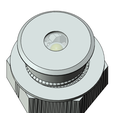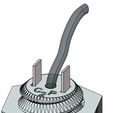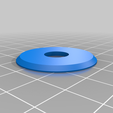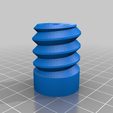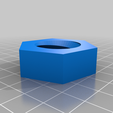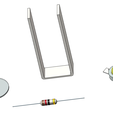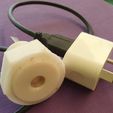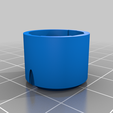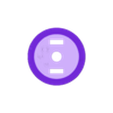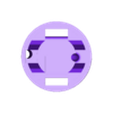3D model description
The inspiration for this was the desire to have a dimmed light over the toilet.
When you need to visit in the middle of the night, you don't necessarily want to be "in the spotlight". For those who sit it's probably not so much of a problem, those standing need some light to aim.
This is a one-watt LED installed in the ceiling through a 25mm (1") hole. It is powered from a USB plug inserted into a USB/ AC adapter. The USB/ AC unit would be plugged into a ceiling socket as are other LED lighting.
There is a little bit of fine soldering required.
As the USB supply is 5 volts, a dropping resistor brings this into the 3 - 3.4 volt range required for the 1W LED.
The length of the heat sink strip is only approximate, the LED will reach about 60 deg. C without it. The aluminium strips can also help in installation (more later)
Parts List:
The five STLs supplied above.
One 1W LED - SMD bead I have used "Warm White" but that's up to you.
One cable with a USB plug on one end - I used an old printer cable and cut the other end off. The cable is stripped to identify the + (red) and - (black) wires, the others are trimmed off.
One 12 Ohm 1/2 W resistor
One heat-sink made from a piece of light aluminium, 0.5 x 5 x 80mm (can be longer)
One USB / AC adapter to suit your AC socket.
One "window", a 15mm diameter piece cut (ground) from an old CD case or similar.
Glue for the printed parts
Assembly:
Once the parts are printed, make sure the "BODY" is a snug fit into the "BOLT" so it can be slid in and glued in place.
Bend the aluminium heat sink into the shape shown with a gap of 11mm.
Insert the heat sink into the two holes in the BODY so it fits flush inside.
Thread the bare end of the cable through the hole in the BOLT and knot it to retain the cable - leaving about 40mm of red and black wires for connection.
Prepare the LED bead by carefully straightening out its leads so they project straight out from the bead.
Place the LED bead in the BODY so it sits on the heat sink and its leads rest in the slots provided.
NOTE the polarity of the LED, many will have tiny "+" and "-" markings on the ends of the leads, some have a small notch on the + side (see pics).
This now becomes a bit tricky -
The BODY has hole in the side leading to one side of the LED, and the central hole has a channel to the other side of the LED.
Holding the LED in place (with one finger) poke the resistor through the hole in the middle of the body so it’s lead goes to the LED opposite the side hole – solder it in place.
You may decide to trim the resistor wire first as it's a bit tight to cut once soldered.
One of the wires from the cable is poked through the side hole of the BODY so it comes through to the LED lead opposite the one with the resistor, Choose the wire (colour) appropriate to the polarity of the LED lead i.e. If the resistor is soldered to the + lead, push the black (-) lead through to the other (-) LED lead. Now solder the remaining wire (red in this case) to the resistor.
Sorry if I'm confusing what is a fairly simple thing - the important thing is to get the polarity right - the resistor just needs to be in series, on either side of the LED.
You can test your work now by plugging the USB plug into any USB (1A +) outlet - If it doesn't light up, check you soldering. If it is possible for the wires to short on the heat sink, sleeve them with a piece of insulation from the wires.
Now glue it together.
Making sure there is enough room for the retaining knot in the BOLT, slip the BODY into the BOLT so it finishes flush at the LED end. If you are happy with the fit, slide it out enough to be able to apply glue slide it back in place.
The clear window should drop in place over the LED and the BEZEL can be glued in place. If you apply extra glue to BEZEL that will also help to keep the window in place.
The NUT and WASHER are used in installation.
Installation:
An AC socket needs to be installed in the ceiling near where you plan to have the light, check the length of the USB cable will reach. This AC socket would be separately switched.
Obviously, you will check that the position of the hole for the light will not coincide with ceiling battens or other structures.
And also; - Before drilling a hole in the ceiling ensure you are clear of any electrical cables / plumbing or other potential catastrophes - maybe this is where you get a licensed electrician in ;)
The hole is 25mm (1") diameter. Ceiling plaster is usually 12mm, this design allows for 20mm ceiling thickness.
Clear any rough edged of the hole and poke the unit up. If you don't have anyone to receive/ hold the unit, "spring" the heat sink legs out a bit to make it stay in the hole.
Back up in the ceiling, attach the WASHER and screw the NUT down - the heat sink legs again help you to hold the unit.
Plug the USB cable into the USB/ AC adapter, into the AC socket
All done!
Enjoy your mood lighting and not destroying your night vision.

/https://fbi.cults3d.com/uploaders/26589087/illustration-file/9e82cfef-4e22-4dec-a414-760a1eda497a/C2P_02.png)
